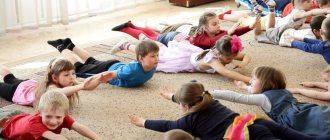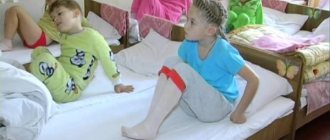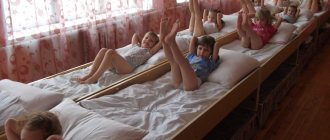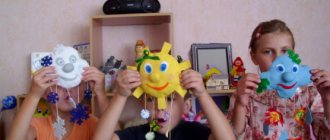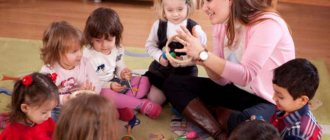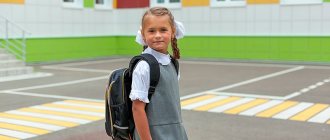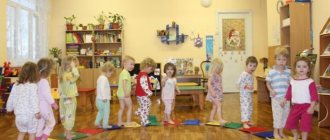In this article we will try to describe those exercises that a mother can independently perform for her child at home without much difficulty and “risk to life.” These exercises can also be performed between professional massage courses.
Before carrying out any professional or self-massage or gymnastics, it would be optimal if the child is examined by a pediatrician, neurologist and orthopedist. Specialists will confirm the absence of contraindications, and will also suggest which areas should be given special emphasis when performing a massage.
However, it should be understood that independent training with your baby, despite the undoubted benefits, will not replace professional massage courses for your child.
Gymnastic exercises for children of the first year of life are best done together with massage, and end with aqua gymnastics.
Gymnastics for children from 0 to 3 months
The optimal age at which it is recommended to start a course of massage and gymnastics is discussed in the article “general principles of massage.” Massage and gymnastics for children of the first year of life
Breathing exercises
Breathing exercises are very important for babies of this age. They promote the development of respiratory muscles, the physiological abilities of the respiratory system, its reserve capabilities, and serve as the prevention of respiratory diseases.
Starting position: the child is in the mother’s arms, facing her. Apply rhythmic pressure with the palm of your hand on the child’s back, moving the palm from the neck to the lower back.
Starting position: the child lies on his back. Alternately moving the handles to the side and up, starting from three months you can perform this exercise with two handles at the same time.
Reflex exercises
Infants have a certain physiological feature of the nervous system - the presence of unconditioned reflexes that appear and disappear at certain times.
Thus, a special group of exercises can be distinguished for infants. These are reflex exercises. They are based on the special evocation of certain unconditioned reflexes.
Naturally, no one will induce the Moro reflex as an exercise (a loud blow on the surface on which the child is lying, while he makes a “hugging” movement).
But some of them, for example the Babinski reflex (special stroking of the foot) or the support reflex are very useful as developmental exercises.
The number of repetitions of reflex exercises during the lesson is 1-2 times.
The exercise is based on the Babinski reflex.
Starting position: the child lies on his tummy.
Apply pressure on the sole at the base of the toes - the child will reflexively bend the toes, then move along the inner edge of the foot to the heel and the outer edge to the little toe - the sole is extended. The movement is performed with the adult's thumb. Repeat 1-2 times. Important! When performing the exercise, the child’s leg is always fixed at the ankle joint (not at the toes).
Reflex exercises at this age also include reflex crawling, reflex support and reflex walking. These exercises are usually carried out at the end of the lesson.
Reflex crawling
The exercise is based on the Bauer crawling reflex.
Starting position: on your stomach. An adult’s palm is placed under the child’s feet, so that the child can rest his slightly bent legs against it. The child pushes and straightens, moving forward. Repeat 1-2 times. Important! Don't forget to leave a clear space where the baby will make this movement (so that he doesn't hit his head).
Reflex support and walking
Starting position: the child is in an upright position, the adult’s hands are in the child’s axillary areas. The child should be allowed to rest his feet completely on the surface of the table. Slightly tilt the child's torso forward, and he will reflexively take several steps.
Laying on the stomach is useful; this is also an exercise for the child, based on the protective reflex (the baby raises and turns his head to the side). In the “on the stomach” position, the muscle tone of the extensors is stimulated, the abdominal muscles are toned, the work of the intestines is stimulated - the removal of “gas” is facilitated, and it prevents constipation.
Laying on the stomach is recommended daily, starting from 30 seconds and up to 15-20 minutes in the first months of life.
Passive exercises
Sliding steps - “stomp”
Starting position: on your back. The leg is bent at the knee and hip joints, the foot rests on the table, and the foot slides along the surface of the table.
Riding in the “embryo” position.
Starting position: the child lies on his back. The legs are bent, brought to the tummy, the head is also bent, the chin is brought to the chest. The baby is “rolled” in this position on his back. As a rule, children really like this exercise.
Active exercises
Various bright, sounding toys are used, which are shown to the child at a distance of 25-30 cm, thus stimulating eye tracking of an object, auditory concentration, and an attempt to grasp the object.
Sleep plays a big role in a baby's life. One of its main tasks is to restore strength from the past day and give energy for the future. The process of waking up after daytime and nighttime sleep is no less important. Most children wake up in a bad mood, and some little ones cannot be woken up at all. This makes life difficult for young parents, since babies can be in no mood throughout the day. To prevent this from happening, you can regularly introduce a healthy set of home exercises into your awakening ritual. You can do gymnastics with your baby without getting out of bed.
Many kindergartens have been practicing children's gymnastics after sleep for several years. It helps babies wake up easier, gives them energy and helps them spend the day more comfortably. Some exercises can be done at home. It is important to exercise in a positive and playful manner so that it is enjoyable for you and your baby.
Little children grow quickly, so it is important to start light physical activity at an early age. In order to grow healthy they will need a lot of strength and energy. Children who are hardened from an early age rarely get sick, and they are also characterized by healthy activity and curiosity. Such kids love to communicate with peers and easily make contact with people.
Gymnastics after a nap develops well:
- vision;
- speech;
- memory;
- endurance;
- patience.
Invigorating gymnastics after sleep helps to cope with waking up easier. Before starting a set of exercises, it is important to prepare your baby’s bedroom:
- ventilate the room;
- let light into the room;
- remove everything unnecessary from the bed and floor so that it does not restrict movement;
- prepare the music;
- if classes are held with additional paraphernalia, it must be prepared in advance. (ball, jump rope, hoop, massage blanket).
You can start doing the exercises right in bed, after the child has opened his eyes. It is important to gradually increase the pace, not to rush:
- Slow awakening . At first, turn on the music quietly, and as you wake up, you can increase the volume. For a more positive mood, choose music that your baby likes, even if it is not too rhythmic. Let the light into the bedroom, open the curtains. Take the blanket off the baby and run your hands over the baby's entire body, starting from the shoulders and ending with the heels. You can give a light massage to your feet and palms.
- Warm up . The simplest thing to start with is stretching. Let your baby stretch several times. Next, you can show your baby an exercise with lifting arms and legs in turn, and also carefully perform circular movements with the neck. Do breathing exercises with your child: inhale and exhale deeply several times. After the child finally wakes up, you can move on to more serious exercises where you need the baby to stand.
- Easy game exercises . Before starting charging, it is recommended to ventilate the bedroom where the baby sleeps. This is done so that you can combine the process of gymnastics with light hardening. Light exercise includes the following set of exercises: get up and walk on your toes, then on your heels, raise your knees high, roll from heel to toe and back, you can make small circular movements with your hands starting from the shoulders, slow bends from side to side, and also back and forth. Then the load can be gradually increased.
As soon as your baby starts doing gymnastics after sleep, the positive effect will not be long in coming. Waking up will not be as difficult for the baby as it was before. In order for the classes to be effective, it is enough to perform the exercises 3-4 times, alternating the load with rest. Then the baby’s muscles will always be in good shape. It is important to ensure that the child’s breathing is uniform and calm during exercises.
The main purpose of the exercises after waking up is that the child, by performing them, moves more easily from a sleepy state to wakefulness.
Exercising after sleep has the following positive effects:
- improves mood;
- increases the child’s perseverance;
- prevents various diseases (scoliosis and flat feet);
- strengthens the respiratory tract system;
- improves the nervous system (makes it more resilient);
- makes the child's immunity strong;
- From childhood, a child begins to lead a healthy lifestyle, starting his day with exercise.
Gymnastics after night and daytime sleep does not make any fundamental difference. The only thing that needs to be adjusted is the time. After waking up at night, you should not study for more than 15 minutes. But after a nap, you can do gymnastics for about half an hour. It is necessary to monitor the child’s condition; the set of exercises should not be tiring. It is important that he finds it interesting and fun. Otherwise, the baby may get bored and subsequently lose interest. To prevent this from happening, monitor your baby’s condition and adjust the time based on his mood. After just a few days of practice, you will know exactly what your child likes.
There are different sets of exercises for each age group. What is suitable for a 2-year-old child will no longer be entirely relevant for a child who is 3 years old or more. Therefore, when choosing exercises, it is important to look at the child’s physical fitness and take into account age restrictions.
Children of school and preschool age can perform more complex physical exercises:
- Cat . The child gets on all fours and bends his back down and back up. The back takes the shape of a wheel.
- Kolobok . The baby lies on his back, tucks his knees to his stomach, wraps his arms around his legs and rolls back and forth, working his abdominal muscles.
- Bike . One of the most popular exercises. It is often done not only by children, but also by adults. The exercise is performed while lying on your back. The child raises his legs and begins to make circular movements, imitating riding a bicycle.
If you do gymnastics, follow all the rules, but the child still wakes up cranky, out of mood, or doesn’t want to get up at all. It is worth paying attention to the rhythm of the baby's day. How long does he stay awake, does the baby sleep enough for his age, is there time in his daily routine for relaxation before bed? Certified children's sleep consultant Tatyana Kremneva will help you understand these and many other questions regarding children's sleep. Come to the “Baby’s Dream” Instagram page, read posts, watch live broadcasts.
Children who exercise after sleep are less likely to get sick or tolerate various diseases much easier. Before you start practicing home gymnastics, you can consult your pediatrician about contraindications.
Author: Tatyana Kremneva.
Gymnastics for children 3-4 months old
In order to avoid repetition, we will add to the above exercises a description of new elements of gymnastics.
Breathing exercises
Starting position: on your back. Simultaneous movement of the arms up and down and circular movements with the arms are added.
Boxing exercise
Starting position: on your back. With your arms bent at the elbows, they are alternately straightened. The movements are reminiscent of boxing. Important! The handles are fixed in the wrist joints to prevent sprains.
Half-turns and turns from back to stomach and back
Starting position: on your back. One hand clasps the child's shins from below, the index finger of the adult's other hand is placed in the baby's palm, and the remaining fingers cover his hand. Then, slightly straightening the child’s legs, you should turn his pelvis, after which the child turns his head and shoulder girdle. Make turns in both directions in a similar manner.
Exercises on the ball
Starting from 3 months, you can introduce a new type of activity - exercises on the ball. For these exercises you will need a ball with a diameter of 50-60 cm, slightly deflated.
Swinging on the ball promotes the development of coordination, the vestibular apparatus, and helps to tone the abdominal muscles, back, and legs.
The baby is placed on the ball in different ways: on the back, on the tummy, and alternately on the sides.
Swings are performed with support on the legs, with legs raised.
It is important to remember to securely secure the child on the ball.
Gymnastics for children 4-6 months
Unconditioned reflexes gradually fade away, so the proportion of passive-active exercises increases. The number of repetitions of the same exercise also increases.
Passive exercises are performed - flexion and extension in large joints.
Circular movements in the hip joints, with the obligatory fixation of the child’s knees with your own hands.
Simultaneous flexion - extension of the legs.
Starting position: on your back. You should grab the child's legs at the bottom of the lower leg from behind, holding the feet. Bend your legs at all joints, pressing them lightly towards your stomach (the baby's knees should be spread apart), then straighten the baby's legs.
Connection of opposite and identical knee-elbow.
The range of exercises on the ball is expanding.
At this age, many children swing with interest on the ball while lifting the toy from the surface.
On the ball in a position on the back, you can rock the baby with a slight “squat” when the legs reach support.
From 5 months, you can rock the baby on its side, pushing off the support surface.
Exercises in bed in the morning for weight loss: 20 exercises
#1 Stretching
First, you need to wake up the body a little, so gymnastics must begin with stretching to warm up and prepare the muscles.
#2 Head rotation
Sit comfortably on the bed, straighten your back. Lower your head forward, back, then to the left, to the right. After this, begin to move your head in a circular motion clockwise and counterclockwise.
No. 3 “Scissors”
An effective workout for your legs. Lie down, lift them up, make quick and wide swings, crossing straight limbs.
No. 4 “Bicycle”
Exercising in bed in the morning for weight loss should include “bicycle” movements. This workout will perfectly prepare your legs for a busy day. Lying down, we raise our legs up and bend our knees slightly, then make circular movements one after another, imitating pedaling on a bicycle.
#5 Crunches
While sitting, begin to twist at the waist, tilting your left and right shoulders alternately. The exercise is effective for reducing and shaping the waist.
No. 6 Pelvic lift
Place your legs bent at the knees wider than your shoulders. Raise your pelvis and lock in the position for 6-9 seconds. Try to bend well, touching the mattress exclusively with your shoulder blades.
No. 7 Birch
A famous school exercise. Raise your straight legs simultaneously to the top with your pelvis, touching the mattress with your shoulder blades and elbows. Hold for a few seconds, then alternately lower your knees behind your head. A more complicated version - both legs together, synchronously. If it’s difficult, you can bend your knees.
No. 8 Bridge
Support yourself with your feet, place your arms at the level of your temples near your head, and turn your fingers toward your shoulders. Slowly push your body up, arching your back, act carefully, feel the spine. As a result, straighten them. Subsequently, you can complicate the procedure by trying to stand up to your full height from the bridge position.
No. 9 Cobra
Performed in a prone position. Hands located at shoulder level are bent at the elbows. Gradually straighten them, raising your upper body. Perform until tension appears in the lumbar region, holding for 6-8 seconds.
#10 Alternate touch
Lie on your back, while raising your right arm and left leg, touching it with your palm. Such actions strengthen the abdominal and leg muscles.
#11 Leg raise
Performed on the side. Sit comfortably on your left side, support your head with your hand. Slowly lift your straight right leg as far as the stretch allows. After 10-11 repetitions, turn over to the other side.
No. 12 Marching
The set of movements will resemble marching if performed while standing, hence the name. Lying on your back, connect your straightened legs and lift them 10-15 centimeters from the mattress. Straighten your arms along your body, helping to keep your legs elevated. Next, in turn, bend your knees, then your right, then your left, pulling them towards your stomach and chin, then straighten them in their original position.
No. 13 Basket
Lie on your stomach, clasp your feet with your palms, pull them up, forming a circle, a “basket”. Arch your back, the effect is like a bridge, only in reverse.
#14 Foot rotation
They also need to be kneaded. First we rotate in one direction, then in the opposite direction. Next we twist in different directions. Can be performed in one step with rotation of the hands.
No. 15 Rotation with hands
A similar exercise, but aimed at the hands. Straighten your palms or clench them into fists and make circular rotational movements. This is especially true for women who type on a keyboard. Effective prevention against carpal tunnel syndrome, in which a nerve is pinched, impairing sensitivity and finger movements.
No. 16 Developing the shoulders
Sit comfortably, put your legs under you. Rotate your shoulders and forearms forward, then back, lift up, down. As a result, the back is strengthened and the posture is straightened.
#17 Shadowboxing
A fun exercise that helps invigorate the entire body. Lying or sitting, punch the air with your fists, simulating boxing with your opponent. Do not move quickly, as there is a risk of damaging your joints. While lying down, you can “kick” the air with your legs.
#18 Push-ups
You can perform this completely while lying on the mattress. Or make it easier by leaving your legs straight on the bed and your hands on the floor. Next, do the standard push-ups. Good for arms, abs and pectoral muscles.
No. 19 Swing your arms
Vaguely reminiscent of scissoring movements performed with the legs. In this case, hands will be involved. Practice swings first along the body, then across the waist.
No. 20 Concentration
In this case, there is no need to bend or twist anything. Lie on your back, arms along your body, legs together. Relax completely for 5-6 seconds, then for the same time, strongly tense all the muscles of the body, feel them. Implement by replacing each other.
The exercises will take 15-25 minutes, but the benefits from them will be noticeable.
Improved well-being, a toned body, energy, optimism and high productivity throughout the day are just a small part of the benefits of morning exercise.
Gymnastics for children 6-9 months
In addition to the exercises already described:
Breathing exercises are done on your back, on your side, or start while sitting.
Simultaneous and alternate abduction of the arms to the sides, upwards, grasping movements with the arms.
All exercises for the legs are performed: “stomps”, sliding steps, circular movements of the legs, alternating flexion and extension.
A new exercise is introduced: cycling.
Starting position: on your back. With the child's legs bent at the hip and knee joints, circular movements are performed, reminiscent of the movement of the legs while riding a bicycle.
In a sitting position (in a tailor's position, when the feet are joined or in a Turkish position), the child is rocked using a toy and encouraged to stretch after it.
Try in every possible way to encourage your baby to actively turn from back to stomach and back.
An exercise aimed at developing crawling skills is useful. During this period of time, you can help the child by substituting your palm as a support.
Exercises are performed to develop walking: stepping from foot to foot is stimulated, while the adult first supports the child’s armpits, and subsequently, the hands of both hands.
In exercises on the ball: you can use swinging on it in a sitting position.
